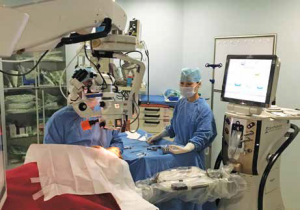
Dr. Priya Narang, MS
Director, Narang Eye Care & Laser Centre
Navrangpura, Ahmedabad
Introduction of the newer and innovative technology has led to significant advancement in the evolvement of the present day cataract surgery. With the advent of Femtosecond laser assisted cataract surgery (FLACS) that presents itself with a host of new clinical and financial challenges, the scope has widened with yielding of accurate effective lens position and decreased higher order aberrations due to achievement of the effective centration and the size of capsulorhexis. In addition to this FLACS performs lens liquefaction and fragmentation thereby resulting in less power utilization during phacoemulsification. In addition to this, the Femtosecond laser technology helps to optimize cataract surgery outcomes by offering high precision in incisional astigmatism management. The downside of the technology is its exorbitant cost and the extra procedure time with the understanding of the fact that surgical outcomes are almost comparable to the conventional cataract surgery. The Nanosecond laser cataract surgery that employs a Nd: YAG laser is being evaluated with promising results that is believed to employ 10% of the total energy as compared with ultrasound and is considered to be endothelial cell friendly.
Intraoperative aberrometry as a technology encompasses a device that is attached to the surgical microscope, which measures the total refractive error of the eye and essentially allows calculating the appropriate refractive power of the eye. This technology has a distinct advantage in post-LASIK patients where error may be induced even with the employment of the most current and updated IOL power calculators. With the application of an appropriate intraoperative estimation of the IOL power and astigmatism axis, optimal visual outcomes can be achieved.
The newly introduced Intraoperative mydriatics like Omidria that comprises of a combination of phenylephrine and ketorolac that helps to achieve and maintain effective mydriasis. This limits the use of pupil expansion devices to some extent that is then reserved for cases with floppy iris. Intracameral injection of epi- Shugarcaine, which is a combination of BSS, epinephrine and lidocaine, is a widely used combination in the western countries. Postoperative medications have been suggested to reduce with the introduction of TriMoxi injection that is given Intravitreally to the patient immediately after cataract surgery either through the pars plana route or with a 27 G cannula inserted through the zonules via ciliary sulcus. A 0.2 ml of the drug is injected into the anterior vitreous and this is stated as Dropless Cataract surgery. The suggested advantage with the use is the better patient compliance as it does away with routine postoperative drug instillation and is cornea friendly.
Figure 1: Femtolaser machine in action
during a cataract surgery.
Figure 2: Safe, accurate and reliable phacoemulsification systems
Apart from the multifocal and accommodative IOL’s there is whole new range of IOL’s that are waiting to be explored. 1-7 With the introduction of Bifocal IOL’s that have a segment for near vision giving two focus zones for better depth of focus and Trifocal IOL’s that provide better intermediate vision, the future of IOL technology seems to be promising. Extended depth of focus (EDOF) IOL’s have an elongated area of focus that extends depth and provides better intermediate vision. The small aperture IOL’s are especially effective in patients with irregular corneal astigmatism where the central pinhole in the IOL imparts extended vision and also facilitates fundus imaging and a Vitreo-retinal surgery when necessary without hindering the view of posterior segment. Light adjustable IOLs from RxSight are specifically designed 3-piece silicon lenses that contain light sensitive macromers that can be modified with an ultra-violet light delivery system in the postoperative period to attain the desired refractive status. Refractive index IOLs from Perfect Lens incorporates the application of femtosecond lasers to create specific patterns that are reversible to correct myopia, hyperopia and astigmatism and induce toric and multifocal changes to the IOL. The multicomponent IOLs have an element of modularity that allows addition and subtraction of optics without the removal of the haptics or body of the device. The FluidVision IOLs change accommodative power of the optic by incorporating controlled amount of fluid depending on the status of refractive error to be corrected.
The ever-expanding horizon of the available options in the cataract surgery has a common goal that aims to optimize the visual outcomes leading to greater patient satisfaction.
References:
1. Wortz GN, Wortz PR, Refractive IOL Pipeline: Innovations, Predictions, and Needs, Curr Ophthalmol Rep. 2017; 5(3): 255- 263.
2. Brierley L. Refractive results after implantation of a lightadjustable intraocular lens in post-refractive surgery cataract patients. Ophthalmology. 2013;120(10):1968–72.
3. Hengerer FH, Dick HB, Conrad- Hengerer I. Clinical evaluation of an ultraviolet light adjustable intraocular lens implanted after cataract removal: 18 months follow-up. Ophthalmology. 2011;118:2382-2388.
4. Josef F. Bille, Johann Engelhardt, Hans-Robert Volpp, Abdelmoutalib Laghouissa, Marcus Motzkus, Zhongxiang Jiang, and Ruth Sahler, “Chemical basis for alteration of an intraocular lens using a femtosecond laser,” Biomed. Opt. Express 2017;8:1390-1404.
5. Ford J, Werner L, Mamalis N. Adjustable intraocular lens power technology. J Cataract Refract Surg. 2014;40(7):1205–23.
6. Guan JJ, Kramer GD, MacLean K, et al. Optic replacement in a novel modular intraocular lens system. Clin Exp Ophthalmol. 2016;44(9):817–23.
7. Portaliou DM, Grentzelos MA, Pallikaris IG. Multicomponent intraocular lens implantation: two-year follow-up. J Cataract Refract Surg. 2013;39(4):578–84.
Figure 3: An intraoperative biometry device


